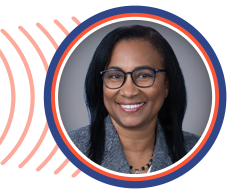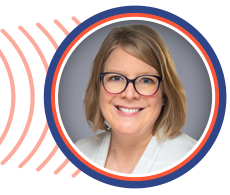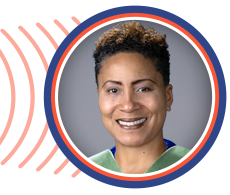1.0 SDMS CME Credit | Category: OT | Content Level: Beginner
Understanding the importance of cleaning is crucial for all healthcare facilities. When employees understand why specific steps matter, they are less likely to skip or neglect them. In a dynamic environment with evolving technologies, responsibilities, and staff changes, ongoing education ensures your team stays up to date. Join us to explore the benefits of automated probe cleaning and its role in preventing Healthcare-Associated Infections.
Objectives:
- Define scientific vocabulary related to cleaning.
- Describe the Spaulding Classification System and explain the significance of a 6-log reduction in high level disinfection.
- Review at least 10 advantages of automated reprocessing over manual reprocessing.
This session is presented courtesy of 

Kendall Ashe, BS
Vice President, General Manager, CS Medical
Kendall Ashe graduated from the University of North Carolina at Chapel Hill with a BS in Chemistry on the Biochemistry track. He is the Vice President and General Manager of CS Medical and the CTO of AMT Group. With over 15 years in the medical device industry and more than a decade of regulatory experience with the FDA, he has secured multiple 510(k) clearances for automated reprocessors, including the TEEClean—the first automated cleaner-disinfector for TEE probes—and the Ethos, the first for endocavity and surface ultrasound probes. Kendall actively serves on multiple AAMI committees and presents monthly HSPA webinars on cleaning and disinfection for sterile reprocessing technicians, offering Continuing Education credits.
1.0 SDMS CME Credit | Category: SPI | Content Level: Intermediate
The pulse-echo technique, used to generate sound for diagnostic ultrasound imaging, has remained largely unchanged for over 50 years. However, advancements such as virtual beamforming, silicon chip technology, GPUs, and single-crystal technology are significantly enhancing image quality without requiring beam focusing. This session will explore how these emerging technologies are implemented in ultrasound systems and their impact on patient care.
Objectives:
- Describe the differences between CPU and GPU processors.
- Explain the process of virtual beamforming.
- Define synthetic transmit focusing and explain how it works.

Kevin Rooker, RDMS, RVT, RT(R)
USCAN Product & Clinical Training Manager, GE Healthcare, Surgical Visualization and Guidance
Kevin Rooker has been a Registered Sonographer for over 40 years, holding certifications in Abdomen (1985), OB/Gyn (1984), Neurosonology (1985), and Vascular (1991). His diverse career includes roles at academic centers, private physician practices, and as the owner-operator of a mobile service. He currently serves as the USCAN Product & Clinical Training Manager for GE Healthcare, Surgical Visualization and Guidance.
Kevin has dedicated much of his career to educating sonographers, physicians, and other healthcare professionals. He has been a featured speaker at local, national, and international sonography conferences and has delivered numerous virtual presentations and webinars.
An active volunteer with the SDMS, Kevin serves as a CME reviewer, subject matter expert, and speaker. He has also been a member of the nominating committee, disinfection task force, and currently serves on the events management committee. Additionally, he sits on three Diagnostic Medical Sonography Program advisory boards and is a Regional Director and Executive Committee Member of the Texas Longhorn Breeders Association of America.
1.0 SDMS CME Credit | Category: OT | Content Level: Intermediate
Ultrasound exams are often seen as quick and simple, but this perception overlooks their complexity and the expertise required. This presentation emphasizes the importance of taking the time to gather complete diagnostic information while protecting your physical and mental well-being. Through case studies, we will explore routine exams that revealed unexpected complexities, highlighting the need for diligence and adaptability. Additionally, we will discuss strategies for managing challenges, maintaining accuracy under pressure, and reducing the risk of work-related musculoskeletal disorders (WRMSDs) and burnout.
Objectives:
- Identify factors that can make routine ultrasound exams unexpectedly complex and explain their impact on patient outcomes.
- Discuss the importance of comprehensive image acquisition and clinical documentation, even under time constraints.
- Review strategies to reduce the risk of WRMSDs and burnout while maintaining high-quality patient care
.
This session is presented courtesy of 

Aubrey Rybyinski, BS, RDMS, RVT, FSDMS
Clinical Manager, Non-Invasive Vascular at AtlantiCare Regional Medical Center
Aubrey Rybyinski, BS, RDMS, RVT, FSDMS, is Clinical Manager, Non-Invasive Vascular at AtlantiCare Regional Medical Center in Pomona, New Jersey. He holds ARDMS credentials in abdominal, breast, neurosonography, OB/GYN, and vascular technology. He earned his BS in Diagnostic Medical Sonography from AdventHealth University in Orlando, FL. Aubrey has authored chapters in multiple medical textbooks and lectured extensively on various ultrasound topics. He actively volunteers for professional organizations and currently serves as President-Elect of the Society of Diagnostic Medical Sonography (SDMS) and on the SDMS Foundation Board of Directors. He previously served as a Board Director for the Intersocietal Accreditation Commission (IAC) Vascular Testing section.
1.0 SDMS CME Credit | Category: OT | Content Level: Beginner
This presentation examines weight stigma in diagnostic imaging and fosters a practical dialogue to support both sonographers and patients in larger bodies.
Objectives:
- Identify factors that influence weight and explain how weight impacts health.
- Analyze the relationship between health, body size, obesity, BMI, medical nutrition therapy, and weight stigma in diagnostic imaging.
- Review practical strategies to support patients of all body sizes.

Jordyn Grantham-Taylor, RD, CRGS
Diagnostic Medical Sonographer, Central Alberta Medical Imaging Services, Alberta Health Services, and Calgary Weight Management Centre
Jordyn Grantham-Taylor, RD, CRGS, is a registered dietitian and diagnostic medical sonographer with a passion for preventative health. With over eight years of experience in diagnostic imaging, primarily in rural clinics, Jordyn observed recurring patterns of poor health among patients. This inspired her to pursue a career in dietetics, believing she could prevent health problems rather than identify them on the exam table. For the past two years, Jordyn has balanced roles in both nutrition and sonography. She has worked with Health Canada and the Bureau of Healthy Eating Policy and Promotion, and most recently as a counseling dietitian at a private practice specializing in obesity management. Jordyn advocates for addressing weight stigma in diagnostic imaging, while recognizing both the modality's limitations and the ergonomic challenges faced by sonographers.
1.0 SDMS CME Credit | Category: OT | Content Level: Beginner
This presentation, developed by the American Registry of Radiologic Technologists (ARRT), provides a comprehensive overview of the ethical standards that guide professionals in medical imaging and radiation therapy. The presentation covers the structure of the ARRT's Standards of Ethics, identifies key ethical principles, and demonstrates how to apply them in real-world examples. Additionally, it teaches how to navigate procedures for ethics violations through interactive case study scenarios. The Standards of Ethics presentation equips technologists with the knowledge and tools needed to uphold ethical standards and navigate complex ethical situations.
Objectives:
- Explain the Structure of ARRT's Standards of Ethics by identifying its key components and describing its importance in professional practice.
- Identify ethical principles in radiologic technology and apply them correctly to real-world case scenarios.
- Outline the steps for addressing ethics violations using ARRT procedures and demonstrate understanding through interactive case study analysis.
This session is presented courtesy of 

Kellie Reynolds, JD, RT (R) (MR) (ARRT)
Vice President of Compliance, American Registry of Radiologic Technologists (ARRT)
Kellie Reynolds, J.D., R.T.(R)(MR)(ARRT), is an attorney licensed in Illinois and Minnesota, currently serving as Vice President of Compliance at the American Registry of Radiologic Technologists (ARRT). She oversees the Ethics Requirements Department, ensuring the highest ethical standards within the radiologic technology profession. In addition to her legal expertise, Kellie holds credentials in radiography and magnetic resonance imaging, offering a comprehensive understanding of the field. She previously chaired the Minnesota State Board of Legal Certification, contributing to the integrity of legal certification in the state. Kellie is also an active member of the Washington County Community Corrections Advisory Board, providing valuable insights on community corrections policies. Kellie’s commitment to ethical standards and legal excellence is evident in her leadership roles across multiple professional boards and organizations, making her a respected voice in both the legal and radiologic technology communities.
1.0 SDMS CME Credit | Category: AB | Content Level: Beginner
This educational presentation will explore a series of intriguing abdominal ultrasound case studies, featuring unique and complex cases that demonstrate ultrasound imaging's diagnostic capabilities and flexibility in both adult and pediatric patients.
Objectives:
- Identify unique and challenging abdominal ultrasound cases.
- Describe diagnostic techniques used and their findings.
- Explain clinical insights and outcomes from the cases presented.

Rose McCalla-Henry, DHSc, RDMS, RDCS, RVT
Program Director/Assistant Professor, Nova Southeastern University
Rose McCalla-Henry, DHSc, RDMS, RDCS, RVT, is the Director of the Medical Sonography Program and Assistant Professor at the Pallavi Patel College of Health Care Sciences, Nova Southeastern University (NSU). A 42-year veteran of the United States Air Force (USAF), she began her career in diagnostic medical sonography. Rose earned a bachelor’s degree in Diagnostic medical sonography from Weber State University, a master’s degree in health administration from Florida Atlantic University (FAU), and a Doctor of Health Science (DHSc) from A.T. Still University (ATSU). She has dedicated many years to serving the profession, including as a JDMS manuscript reviewer, SDMS CME reviewer, and member of the Membership and Awards (MAR) committee. Rose has also contributed to the SDMS Scope of Practice task force and as an item writer for the American Registry of Diagnostic Medical Sonography (ARDMS). She currently serves as an SDMS liaison and secretary for the Joint Review Committee for Cardiovascular Technology (JRC-CVT).
1.0 SDMS CME Credit | Category: AE | Content Level: Intermediate
This 50-minute lecture explores the role of contrast in echocardiography, highlighting its clinical applications, benefits, and global variations in use. Cardiac sonographers will learn how contrast enhances imaging quality, improves diagnostic accuracy, and aids in evaluating conditions such as ischemia and ventricular dysfunction. The session will also cover administration techniques, safety protocols, and emerging trends in contrast echocardiography.
Objectives:
- Identify clinical indications for contrast use and evaluate the impact on image quality and diagnostic accuracy.
- Compare globally used contrast agents, including their availability, benefits, and limitations.
- Demonstrate administration techniques, safety protocols, and describe emerging advancements in contrast echocardiography.

Kristy Crow, BS, RDCS, RVT, RDMS, FASE
Senior Sonographer/Educator, University of Iowa Healthcare
Kristy Crow is a seasoned ultrasound professional with nearly 15 years of experience. A proud alumna of the University of Iowa's Diagnostic Medical Sonography program, she has specialized in adult congenital, pediatric, and fetal echocardiography. Currently a senior sonographer in pediatric cardiology, Kristy plays a key role in diagnosing complex cardiac conditions in young patients and training cardiology fellows. In addition to her clinical work, Kristy teaches Radiation Sciences, nurturing aspiring sonographers. She actively volunteers with organizations like SDMS, ASE, and ARDMS, further advancing the profession. Kristy also consults for Lantheus Imaging (Definity), providing education and image optimization to ensure diagnostic accuracy. Her diverse contributions reflect her dedication to excellence and innovation in medical imaging.
1.0 SDMS CME Credit | Category: OT | Content Level: Intermediate
This lecture offers an overview of veterinary ultrasound and its applications in the field. It will feature several cases showcasing sonographic appearances of normal small animal anatomy and pathology, including abdominal and cardiac exams, presented through an interactive audience approach.
Objectives:
- Review the landscape of the veterinary sonography field.
- Identify normal and abnormal sonographic findings in abdominal veterinary ultrasound cases.
- Compare normal and abnormal sonographic findings in veterinary echocardiogram cases.

Emily Downs, MEd, RDMS, RVT, RDCS, RT
Owner, Focused Ultrasound Resources
Emily graduated from the University of Nebraska with a Bachelor's in Radiation Sciences and a Master's in Education. She served as the Program Director and is a proud alumnus of the Diagnostic Medical Sonography program at the University of Colorado Hospital in Denver, CO. In this role, she taught across all areas of the program curriculum and performed general, vascular, high-risk obstetric, and fetal echocardiography ultrasound. Emily is an active member of the SDMS and has authored several publications. She has served on the board of directors for the International Foundation for Sonography Educators and Research (IFSER) and works as a temporary advisor and international educator with the Pan American Health Organization (PAHO). With a passion for animals, Emily transitioned to veterinary sonography, co-founding Focused Ultrasound Resources (FUR). She performs small animal ultrasound throughout the Denver area, teaches at Colorado State University School of Veterinary Medicine, and provides lectures for local veterinary hospitals.
1.0 SDMS CME Credit | Category: VT | Content Level: Beginner
This presentation will explore the use of Transcranial Doppler ultrasound (TCD) and other non-invasive medical imaging techniques to assess cerebral blood flow. We will discuss how these methods provide valuable information for diagnosing brain death by evaluating blood circulation in the brain.
Objectives:
- Identify the characteristics of patients with brain death.
- Explain the advantages of using non-invasive imaging to diagnose brain death.
- Describe the limitations and pitfalls of ultrasound and other imaging modalities.

Lonette Spence, DHSc, RVT
Assistant Professor, Nova Southeastern University
Lonette Spence, DHSc, is an Assistant Professor/Clinical Coordinator at Nova Southeastern University in Fort Lauderdale, FL, with over 20 years of experience in vascular ultrasound. She has worked as a staff and travel sonographer at various hospitals and private practices. Dr. Spence earned her Bachelor of Arts in Psychology from Oakwood University (1994), a certificate in Vascular Technology from the University of Medicine and Dentistry of New Jersey (2004), a Master’s in Administration from Fairleigh Dickinson University (2005), and a Doctor of Health Science degree from Nova Southeastern University (2015).
Lonette is an active member of the Society of Diagnostic Medical Sonography (SDMS) Foundation and serves as a journal manuscript reviewer for the Journal of Diagnostic Medical Sonography (JDMS). She also serves on two SDMS committees: Membership Awards & Recognition (MAR) and Virtual Member (Vascular) SDMS Event Management. A lifelong learner and member of the Alpha Eta Society, Lonette is committed to self-development. She values mentorship and is dedicated to equipping her students with the tools and resources to help them succeed as sonographers.
1.0 SDMS CME Credit | Category: OB | Content Level: Intermediate
This presentation explores the role of ultrasound in diagnosing fetal syndromes, focusing on real-world case studies. Participants will learn to identify key sonographic markers and interpret diagnostic findings. Through case-based discussions, learners will deepen their understanding of the variability in ultrasound presentations and how these findings correlate with clinical outcomes. The session aims to enhance sonographers' skills in the early detection of fetal syndromes.
Objectives:
- Identify the key features and diagnostic criteria of common fetal syndromes.
- Explain the etiology and pathophysiology of fetal syndromes.
- Analyze multiple ultrasound findings and correlate them with specific syndromic diagnoses.

Angelena Zehm, MEd, RDMS, RDCS, RVT
DMS Program Director, Keiser University
Angelena Zehm is the DMS Program Director at Keiser University in New Port Richey, Florida, a role she has held for the past seven years. With 16 years of experience in formal sonography education, both in virtual and in-person settings, Angelena brings over 30 years of clinical sonography experience. She has worked as a staff, mobile, travel, and lead sonographer in Wisconsin and Minnesota before relocating to Florida. Angelena earned her master’s degree in education with a focus on allied health teaching and leadership from Keiser University. An ARDMS-registered sonographer, her specialties include abdomen, breast, obstetrics and gynecology, pediatric, vascular, and adult echocardiography. She currently volunteers as a CME reviewer for the SDMS and serves on the SDMS Membership Awards and Recognition Committee and the SDMS Event Management Committee. She also presented at the 2024 SDMS Virtual Conference and SDMS CME Crunch Week. In her free time, Angelena enjoys reading, spending time with her golden retrievers, and cruising the Caribbean.